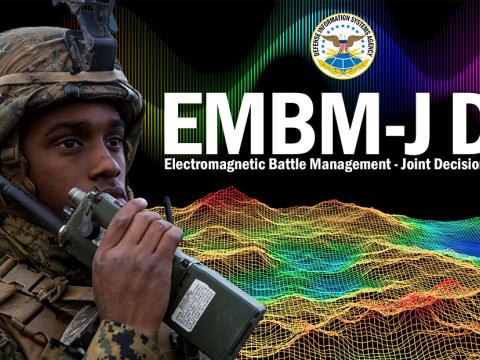Bringing U.S. Dominance to the Spectrum
While the U.S. military may be the most powerful in the world, near-peer adversaries have evolved asymmetric threats to gain an advantage in a fight. One current conflict has demonstrated the need for the U.S. Department of Defense (DoD) to strengthen its use of the electromagnetic spectrum and radio spectrum.
Background
Ever since Russia invaded Ukraine in February 2022, the conflict has served as a testing ground for the U.S. military and its NATO allies. Even though the weapons systems used by Ukraine in the opening days of the war were not the latest generation, those systems had never been used in a near-peer conflict and provided several useful lessons.
Where new technology did make a mark was in tactical communications and information-sharing. Early in the war, in this era of ubiquitous smartphone use, news reports documented how Ukrainian troops targeted their opponents by tracking the location of cellphone signals, and the Russians did the same. The U.S. Army has reported the many ways smartphone technology is influencing the Ukrainian battlefields, including expanding the ways civilians can crowdsource vital on-the-ground intelligence.
As the war has gone on, other weaknesses in current U.S. military technologies have emerged, particularly in the field of communications. The Washington Post recently reported the Russian military is having success jamming U.S.-provided satellite-guided munitions and drones.
“Russia’s ability to combat the high-tech munitions has far-reaching implications for Ukraine and its Western supporters — potentially providing a blueprint for adversaries such as China and Iran — and it is a key reason Moscow’s forces have regained the initiative and are advancing on the battlefield,” reads a portion of the article.
These developments make clear that the DoD should pursue “spectrum dominance,” enabling friendly forces to control the electronic warfare/radio frequency (EW/RF) spectrums and deny those domains to enemy forces.
“Just as air dominance means that U.S. air power controls the airspace in a kinetic fight, spectrum dominance means U.S. forces can send data and communicate while denying the enemy the ability to do so,” said Dave Peterson, founder and CEO, Fenix Group Inc., part of Nokia Federal Solutions.
In 2022, the Congressional Research Service (CRS) defined EW as military activities that use electromagnetic energy to control the electromagnetic spectrum and attack an enemy.
“EW supports command and control by allowing military commanders access to the spectrum to communicate with forces, while preventing potential adversaries from accessing the spectrum to develop an operational picture and communicate with their forces,” it wrote.
The DoD itself recognizes its weakness in this area. The CRS report noted in 2022, the National Defense Strategy Commission also observed that the United States “is losing its advantages in electronic warfare, hindering the nation’s ability to conduct military operations against capable adversaries.”
Just this past May, now-retired Lt. Gen. Mike Nagata, who led special operations in the Middle East, said at the annual Special Operations Forces Week that the U.S. military is still falling behind its potential adversaries in EW. He suggested the Pentagon needs to get more creative in using radio technologies.
The U.S. military once led the world in areas such as night vision, glide weapons and satellites, but no longer provides overmatch advantages against prospective foes.
“The only areas where DoD still has an overmatch advantage are the level of our training and our intelligence networks,” Peterson said. “In order to defeat an enemy, speed is life. Our commanders must be able to disseminate intelligence to a firing platform, whether a warship, an aircraft or an individual soldier, faster than our enemy.”
Bringing 3GPP to the Battlefield
In the simplest terms, it is not a good idea to present an electromagnetic signature in a hostile environment that doesn’t belong there. This must be considered as the DoD looks at ways to deploy 3GPP in the battlespace.
“Currently, U.S.-made legacy military radios being used in Ukraine are extremely easy for the Russian military to target because they use a proprietary signaling methodology,” Peterson said. “The Russians don’t necessarily care about intercepting the radio traffic; they simply geolocate the signal and target it with fires.”
3GPP — Third Generation Partnership Project — is the umbrella term for several telecommunications standard development organizations that develop the protocols for mobile telecommunications. While 5G is the current leading-edge technology, Peterson said 3GPP is the more accurate term because it includes the widely used 4G/LTE standard, which also could be used.
The advantages to 3GPP are clear: much higher data transmission rates and much lower signal latency. The biggest disadvantage of 5G is the need for many more transmitters since the signals do not travel as far, which is why the 4G/LTE standard also represents a good solution.
“No other waveform made by man can provide the bandwidth, user capacity and mobility that 3GPP networks can,” Peterson said. “Legacy systems are extremely bandwidth-restricted, but 3GPP presents the opportunity for the DoD to massively scale throughput for data intelligence dissemination — what we call ‘democratized intelligence dissemination’ — to provide an overmatch advantage for U.S. and allied forces.
“As the U.S. military gets closer to deploying 5G, they must think of the threat and base their tactics, techniques and procedures (TTPs) around it. 5G can be used in a hostile environment, but carefully and with proper TTPs applied.”
The Crucible of Battle Brings Innovation
There are differences in Russian and U.S. doctrines regarding EW capabilities. Ukrainian troops are adapting on the fly to the spectrum challenges.
“They know how long the jammers will emit. They plan their offensives around it, such as using wire-guided drones to handle Russian jamming,” Peterson said.
Steve Vogelsang, chief technology officer at Nokia Federal Solutions, said the U.S. military is very competitive, but battlefield communications need to change.
“It’s no longer voice-only communications. They need to have large volumes of data from sensors to move around,” Vogelsang said. “The technology best suited for that is 3GPP; the military recognizes that. They get it, but now they need to put it into practice much more quickly.”
Another possible battlefield innovation is finding ways to bring a private network with the troops.
“The Russians are operating on Ukrainian networks,” Vogelsang said. “They’re kids. You can train them forever, but they’re still going to want to get online, go to social media.”
The Russian forces are full of conscripts and young people, not experienced troops.
The same behaviors apply to U.S. and allied troops, but training them about the risks of using public networks and the importance of staying on military-provided private networks can offset much of the danger, Peterson said.
The DoD has ambitious plans for the future of the U.S. military, such as the combined joint all-domain command and control initiative, which envisions a unified common operating picture and information environment that can share data rapidly at multiple operational and security levels.
“Interconnecting every platform, every sensor, every soldier, is through 3GPP,” Peterson said. “That’s why there’s so much interest in 5G and beyond. That’s our goal: to teach them how it can be utilized and how to bring it to the boots on the ground.”
Spurring Innovation in the U.S. Military
Vogelsang noted advances in the use of spectrum are driven by industry, not the military.
“Industry is moving superfast,” he said. “The DoD has to find ways to leverage that.”
One suggestion is to require the departments, particularly the Army and Marine Corps, to allow flexibility in their junior ranks to experiment with solutions, similar to Ukrainian troops’ adaptations, but without being under enemy fire.
“Organizations like DARPA or the Defense Innovation Unit are trying to find innovative technologies, but it’s very difficult to scale that,” Peterson said, referring to the Defense Advanced Research Projects Agency. “Instead of centralizing funding in one or two specific organizations, spread it out to different divisions within the Army and experiment in the mud with alternative solutions. Whatever works is going to bubble to the top. It’s a case of fail fast, dedicate people to solving the problems and find what works, then scale it.
“The first person to receive data intelligence and act upon it through targeting and a decision matrix to shoot will win. The overmatch comes from the network. Throughput matters. Security matters. Reliability and redundancy matter, especially when we’re talking about spectrum dominance.”
For more information: nokia.com/defense





Comments